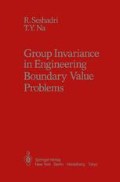Abstract
The mathematical descriptions of large number of physical problems arising in science and engineering manifest themselves as nonlinear differential equations. Since there is an abundance of methods for dealing with linear differential equations, a popular practice has been to introduce some form of approximation that would linearize the nonlinear equation. These approximations usually impose certain restrictions on the solutions. In this chapter, we will discuss procedures for deriving mappings based on group- theoretic motivations that transform a nonlinear differential equation into a linear differential equation.
Access this chapter
Tax calculation will be finalised at checkout
Purchases are for personal use only
Preview
Unable to display preview. Download preview PDF.
References
Na, T.Y, and Hansen, A.G.,“Similarity Analysis of Differential Equations by Lie Group”,J. of Franklin Institute, Vol. 6,p. 292 (1972).
Bluman, G.W.,“Use of Group Methods for Relating Linear and Nonlinear Partial Differential Equations”, Symmetry, similarity and Group Theoretic Methods in Mechanics, Proc. of Symposium, Univ. of Calgary, Canada (1974).
Na, T.Y. and Seshadri, R., “Nonlinear to Linear Dif. Eqs. Using Transformation Groups”, 4th Int. Sym. on Large Engineering Systems, The University of Calgary, Canada (1982).
Bluman, G.W., “On the Remarkable Nonlinear Diffusion Equation”,, J. Math. Phys.,Vol. 21,No. 5 (1980).
Anderson,R.L.,Kumei,S., and Wulfman, C.E., Rev.Mex. Fis.,Vol.21, No.1, p.35 (1972)
Anderson,R.L.,Kumei,S., and Wulfman, C.E., Phys. Rev. Lett.,Vol. 28, p. 988 (1972).
Kumei, S. and Bluman, G.W.,“When Nonlinear Differential Equations are Equivalent to Linear Differential Equations”,SIAM J. of Appl. Math., Vol. 42, No. 5 (1982).
Na, T.Y. and Seshadri, R.,“From Nonlinear to Linear Equations Using Transformation Groups”,Report No. 82-001, Fluid Mechanics Laboratory, University of Michigan, Dearborn Campus (1982).
Author information
Authors and Affiliations
Rights and permissions
Copyright information
© 1985 Springer-Verlag New York Inc.
About this chapter
Cite this chapter
Seshadri, R., Na, T.Y. (1985). From Nonlinear to Linear Differential Equations using Transformation Groups. In: Group Invariance in Engineering Boundary Value Problems. Springer, New York, NY. https://doi.org/10.1007/978-1-4612-5102-6_10
Download citation
DOI: https://doi.org/10.1007/978-1-4612-5102-6_10
Publisher Name: Springer, New York, NY
Print ISBN: 978-1-4612-9564-8
Online ISBN: 978-1-4612-5102-6
eBook Packages: Springer Book Archive

